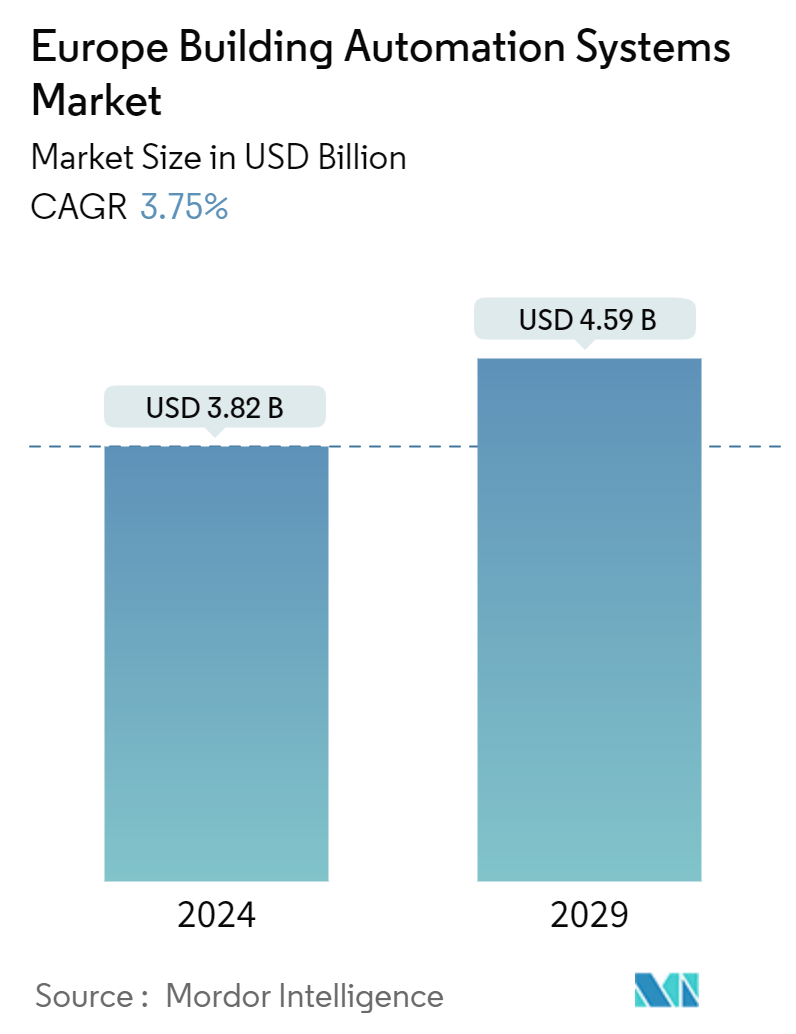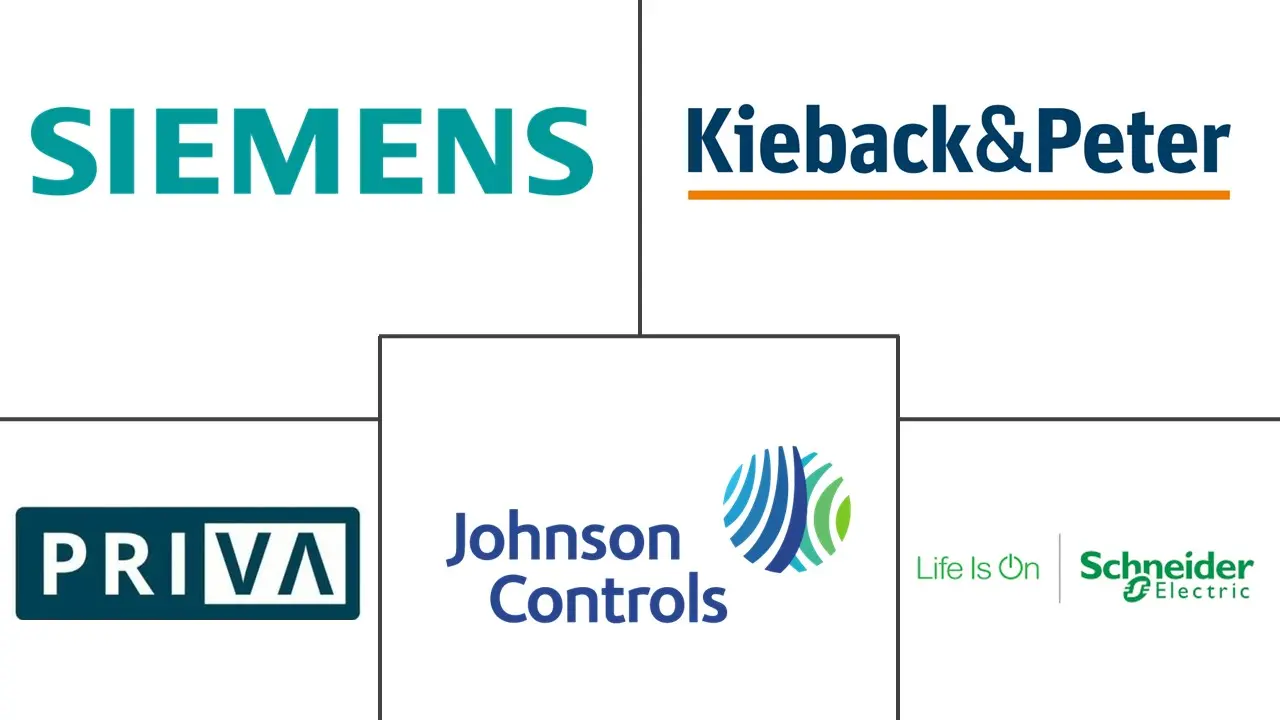Market Size of Europe Building Automation Systems Industry

| Study Period | 2019 - 2029 |
| Base Year For Estimation | 2023 |
| Market Size (2024) | USD 3.82 Billion |
| Market Size (2029) | USD 4.59 Billion |
| CAGR (2024 - 2029) | 3.75 % |
| Market Concentration | Low |
Major Players
*Disclaimer: Major Players sorted in no particular order |
Europe Building Automation Systems Market Analysis
The Europe Building Automation Systems Market size is estimated at USD 3.82 billion in 2024, and is expected to reach USD 4.59 billion by 2029, growing at a CAGR of 3.75% during the forecast period (2024-2029).
- A building automation system (BAS), also known as a building control or building management system, controls various electric, electronic, and mechanical systems within a building. This includes building management systems, HVAC controls, lighting controls, fire detection, and security systems. The scope of the system encompasses end users in both commercial and residential settings. The construction industry is crucial in helping the EU achieve its energy and environmental goals. Constructing more energy-efficient buildings will improve residents' living standards, reduce energy poverty, and contribute to the economy and society by creating green jobs. Additionally, it will lead to better indoor air quality and overall health benefits.
- The demand for IoT products is increasing in Europe. Germany, the United Kingdom, and the Netherlands lead the region's IoT adoption, followed closely by Eastern Europe and the Nordics. While the manufacturing, housing, health, and finance industries are at the forefront of IoT adoption, the retail and agricultural industries are also making significant progress. The demand for outsourcing continues due to a shortage of qualified specialists and a growing willingness to outsource. The technology for building automation systems (BAS) has advanced significantly and is constantly improving with new capabilities. However, many building managers still manually operate HVAC systems because they lack confidence in the building automation system. Unfortunately, many buildings with fully functional building automation systems run their equipment manually by building operators due to a lack of understanding or the installation contractors not configuring the building automation system.
- Countries such as France, the United Kingdom, and Germany contribute considerably to the market growth, primarily due to the increase in urban population, which generates significant demand for building automation systems. In France, in 2023, the total population was over 68 million. The population in the nation increased since the mid-2000s. The Ile-de-France was the most populous region in France in the same year. INSEE said more than 12 million French citizens lived in the Ile-de-France region. Ile-de-France was followed by Auvergne-Rhône-Alpes and Nouvelle-Aquitaine region in the Southern part of the country.
- Moreover, the growing residential construction across Europe will create new market opportunities for the building automation system in the coming years. According to Centraal Bureau voor de Statistiek, since 2000, the Netherlands has added between 44,000 and 86,000 new houses per year to the housing stock, showing an overall slower construction activity than in the 1970s, when the annual number of new homes added ranged between 77,000 and 143,000. In 2023, the number of home completions amounted to approximately 79,000.
Europe Building Automation Systems Industry Segmentation
Building automation systems exhibit functions such as control of the building's environment, operating systems depending on the energy need, and monitoring the system enactment, based on which the systems produce sound alerts as needed. It centrally controls the building's heating, ventilation, air conditioning (HVAC), electrical, access control, and other interrelated systems.
The European building automation systems market is segmented by component (hardware [controllers and field devices] and software-as-a-service), end user (residential, commercial, and industrial), and country (Germany, United Kingdom, France, Spain, Italy, and Rest of Europe). The report offers the market size and forecasts for all the above segments in value (USD).
| By Component | ||||
| ||||
| Software-as-a Service |
| By End User | |
| Residential | |
| Commercial | |
| Industrial |
| By Country*** | |
| Germany | |
| United Kingdom | |
| France | |
| Spain | |
| Italy | |
| Netherlands | |
| Belgium | |
| Sweden | |
| Finland | |
| Denmark |
Europe Building Automation Systems Market Size Summary
The European building automation systems market is poised for significant growth, driven by advancements in technology and increasing demand for energy-efficient solutions. Building automation systems, which encompass various components such as lighting controls, HVAC systems, and security measures, play a crucial role in enhancing the energy efficiency and operational efficiency of buildings. The market is experiencing a surge in interest due to the growing adoption of Internet of Things (IoT) technologies and the integration of artificial intelligence and smart sensors in commercial buildings. These systems are not only vital for meeting the European Union's energy and environmental goals but also contribute to improving living standards, reducing energy poverty, and fostering economic growth through the creation of green jobs.
The market's expansion is further supported by regulatory mandates and the rising value of commercial real estate in Europe. Governments are implementing policies that require large non-residential buildings to be equipped with advanced building automation functions, thereby driving demand. The commercial segment, which includes offices, hospitals, and retail spaces, is witnessing increased traction due to the need for enhanced security and safety measures. Additionally, the market is characterized by intense competition, with major players like Siemens AG, Johnson Controls International PLC, and Schneider Electric SE actively engaging in partnerships and technological innovations to maintain a competitive edge. The post-pandemic recovery has also spurred growth, as construction projects resume and the demand for improved ventilation and air quality systems rises.
Europe Building Automation Systems Market Size - Table of Contents
-
1. MARKET INSIGHTS
-
1.1 Market Overview
-
1.2 Industry Attractiveness - Porter's Five Forces Analysis
-
1.2.1 Bargaining Power of Suppliers
-
1.2.2 Bargaining Power of Buyers
-
1.2.3 Threat of New Entrants
-
1.2.4 Threat of Substitutes
-
1.2.5 Degree of Competitive Rivalry
-
-
1.3 Industry Value Chain Analysis
-
1.4 Impact of COVID-19 Aftereffects and Other Macroeconomic Factors on the Market
-
-
2. MARKET SEGMENTATION
-
2.1 By Component
-
2.1.1 Hardware
-
2.1.1.1 Controllers
-
2.1.1.2 Field Devices
-
-
2.1.2 Software-as-a Service
-
-
2.2 By End User
-
2.2.1 Residential
-
2.2.2 Commercial
-
2.2.3 Industrial
-
-
2.3 By Country***
-
2.3.1 Germany
-
2.3.2 United Kingdom
-
2.3.3 France
-
2.3.4 Spain
-
2.3.5 Italy
-
2.3.6 Netherlands
-
2.3.7 Belgium
-
2.3.8 Sweden
-
2.3.9 Finland
-
2.3.10 Denmark
-
-
Europe Building Automation Systems Market Size FAQs
How big is the Europe Building Automation Systems Market?
The Europe Building Automation Systems Market size is expected to reach USD 3.82 billion in 2024 and grow at a CAGR of 3.75% to reach USD 4.59 billion by 2029.
What is the current Europe Building Automation Systems Market size?
In 2024, the Europe Building Automation Systems Market size is expected to reach USD 3.82 billion.

